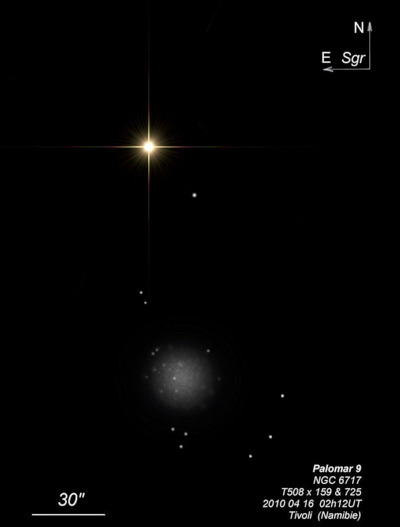
William Herschel discovered NGC 6717 = H III-143 = h2022 = h3766 on 7 Aug 1784 (sweep 245) and recorded "two or three minutes south of 35 Sagittarii are three vS stars which I suspect to contain nebulosity; but it is probably a deception, circumstances are not favourable enough to determine it." His position was accurate. At the Cape of Good Hope on 27 Jun 1837 (sweep 793), John Herschel reported "Close, to the south of, Nu2 Sagittarii; a very small clustering knot, with perhaps nebula. A doubtful object. I see 3 or 4 of the st, but there is also a nebulous appearance."
According to Harold Corwin, Bigourdan's IC 4802, described as "neb *13, 15" nf III 143 [NGC 6717]" refers to a clump of stars northeast of the nucleus of NGC 6717 but part of the cluster. George Abell found the cluster again while inspecting plates for the POSS1 around 1952 and didn't make the connection with NGC 6717. As a result, this globular is also known as Palomar 9!
300/350mm - 13" (6/18/85): fairly faint, very small. This globular appears as a hazy patch easily visible just 1.8' S of Nu 2 = 35 Sagittarii (V = 5.0)! About half a dozen stars are either superimposed or resolved including two close pairs.
400/500mm - 17.5" (7/20/98): very unusual small, faint glow located 2' S of mag 5 Nu 2 Sagittarii! The very faint background glow is ~1' diameter but more notable are several superimposed stars. A close pair of mag 13.5 stars is at the NE edge 25" from center (this is IC 4802!) and a similar star is at the WNW edge 20" from center. A very small bright core appears on closer inspection to be a close pair of mag 12.5 stars or possibly a bright stellar core and nearby star. Other than the central "knot", the unconcentrated 1' background patch has a low surface brightness and is much smaller than the listed diameter of 4'.
600/800mm - 24" (8/23/14): this unusual globular, located just 2' S of Nu2 Sgr, was viewed at 375x and 500x. The "core" appears as a fairly circular, fairly smooth glow, ~1' diameter, with a half-dozen stars superimposed. With extended viewing a very low surface, irregular halo was noticed that increased the diameter to perhaps 2.5'. At the center is an unequal pair oriented N-S (~5" separation), with the southern component, brighter and quasi-stellar. A second pair of mag 14 stars at ~5" separation is on the NE side (this is IC 4802). A mag 16 star is 10" S of this pair. Finally, another mag 14 star is at the WNW side of the core.
Notes by Steve Gottlieb